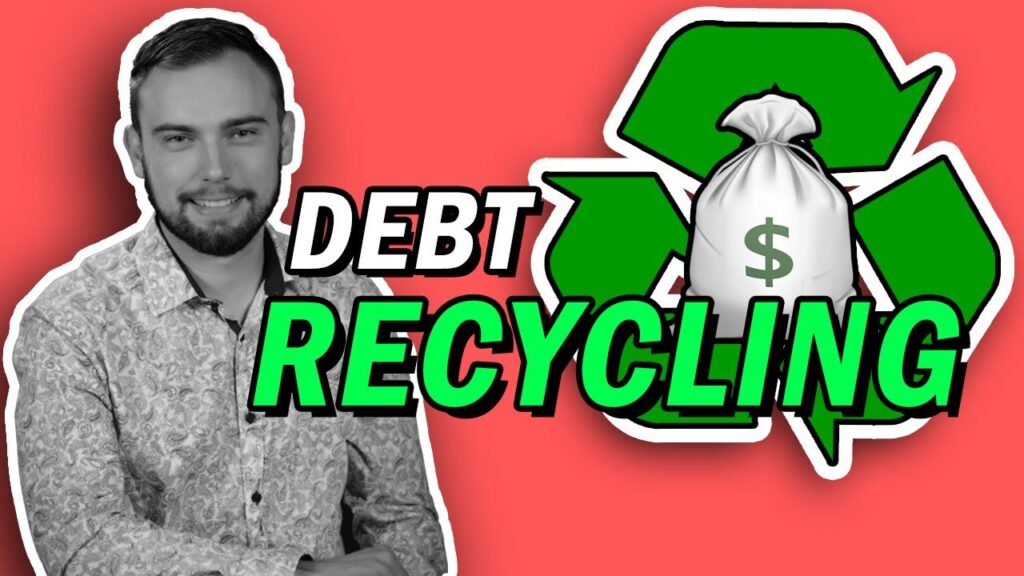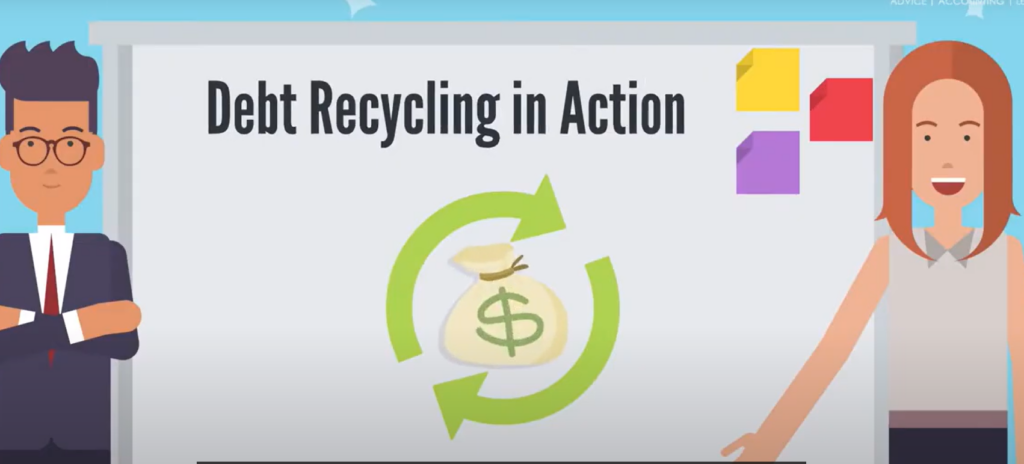Debt recycling is a financial strategy that allows individuals to optimize their debt and investment portfolio to potentially increase their wealth over time. By leveraging the equity in their property, borrowers are able to generate new investable funds that can be used for wealth creation. Debt recycling is an increasingly popular strategy among savvy investors who are looking for ways to maximize their returns while managing their debt effectively.
Understanding the Concept of Debt Recycling
Debt recycling is a concept that involves using the equity in your property to invest in income-generating assets. The basic idea is to borrow against the equity in your property, usually through estate planning advisor recommended by financial advisor Sydney. The borrowed funds are then used to invest in assets such as shares, managed funds, or property, which have the potential to generate additional income or capital growth.
Definition and Basic Principles of Debt Recycling
Debt recycling is essentially a strategy that involves converting non-tax-deductible debt, such as a home loan, into tax-deductible debt. By doing so, individuals can potentially reduce their overall interest expenses and improve their after-tax investment returns. The basic principle behind debt recycling is to redirect the cash flow from the income generated by the investment portfolio towards paying off the non-deductible debt. This creates a cycle where the debt is effectively recycled for wealth creation purposes.
Related: The Essentials of a Debt Recycling Strategy
The Mechanics of Debt Recycling
The mechanics of debt recycling involve three main steps: borrowing against the equity in your property, using the borrowed funds to invest in income-generating assets, and using the income generated by the investment portfolio to pay down the non-deductible debt. This cycle creates a tax-efficient structure where the interest expenses on the investment debt are tax-deductible, while the income generated by the investment portfolio is used to offset the non-deductible debt. Over time, this can potentially accelerate the repayment of the non-deductible debt and increase the investment portfolio’s value.
Let’s delve deeper into the mechanics of debt recycling. When borrowing against the equity in your property, it’s important to consider the interest rates and terms offered by different financial institutions. By carefully comparing and selecting the most favorable terms, you can maximize the benefits of debt recycling.
Once you have obtained the borrowed funds, it’s time to invest in income-generating assets. This step requires careful consideration and research. You may choose to invest in a diversified portfolio of shares, which can provide both income through dividends and potential capital growth. Alternatively, you could opt for managed funds, which are professionally managed investment vehicles that pool money from multiple investors to invest in a range of assets. Property investment is another option, with the potential for rental income and capital appreciation over time.
As the income starts flowing in from your investment portfolio, it’s essential to have a clear plan for using it to pay down the non-deductible debt. This can be done by directing the income towards making additional repayments on your home loan or other non-deductible debt. By consistently channeling the income towards debt reduction, you can effectively recycle the debt and accelerate its repayment.
It’s important to note that debt recycling requires careful financial planning and consideration of your individual circumstances. Seeking advice from a qualified financial advisor can help you determine if debt recycling is suitable for you and assist in creating a tailored strategy to achieve your financial goals.
The Benefits and Risks of Debt Recycling
Debt recycling offers several potential advantages for individuals who are looking to build wealth over the long term. However, like any financial strategy, it also carries some risks and drawbacks that need to be taken into consideration.
Potential Advantages of Debt Recycling
One of the main benefits of debt recycling is the potential for increased wealth creation. By redirecting the income generated by the investment portfolio towards paying down the non-deductible debt, individuals can effectively boost their net worth over time. This strategy allows individuals to leverage their existing assets and generate additional wealth through smart investment decisions.
Additionally, debt recycling can also provide individuals with a more tax-efficient structure, as the interest expenses on the investment debt are tax-deductible. This means that individuals can potentially reduce their taxable income and keep more of their hard-earned money in their pockets. By taking advantage of tax benefits, individuals can optimize their financial situation and maximize their overall wealth accumulation.
Another advantage of debt recycling is the ability to diversify investment holdings. By using the borrowed funds to invest in different asset classes, individuals can spread their risk and potentially achieve higher returns. This diversification can help protect against downturns in any specific asset class and provide a more balanced investment portfolio. By carefully selecting a mix of investments, individuals can increase their chances of long-term financial success.

Possible Drawbacks and Risks
While debt recycling can be an effective wealth creation strategy, it’s important to consider the potential risks involved. One of the main risks is the possibility of investment losses. Investing in income-generating assets always carries a certain level of risk, and individuals need to carefully consider their risk tolerance before embarking on a debt recycling strategy. It’s crucial to conduct thorough research and seek professional advice to ensure that the investments chosen align with personal financial goals and risk tolerance.
Another potential drawback of debt recycling is the increased level of debt. By taking on additional debt to invest, individuals are exposed to higher levels of financial risk. It’s important to have a solid plan in place to manage and repay this debt effectively. This includes creating a budget, monitoring cash flow, and having a contingency plan in case of unexpected financial challenges. With careful planning and disciplined financial management, individuals can mitigate the risks associated with debt recycling and ensure long-term financial stability.
In conclusion, debt recycling can offer significant benefits for individuals seeking to build wealth over the long term. It provides opportunities for increased wealth creation, tax efficiency, and diversification of investment holdings. However, it’s crucial to carefully consider the potential risks and drawbacks, such as investment losses and increased debt levels. By conducting thorough research, seeking professional advice, and implementing effective financial management strategies, individuals can make informed decisions and optimize the benefits of debt recycling.
Key Strategies for Successful Debt Recycling
Successfully implementing a debt recycling strategy requires careful planning and consideration of various factors. Here are some key strategies to help you achieve success:
Debt recycling is a financial strategy that involves leveraging your home equity to invest in income-producing assets, with the aim of generating long-term wealth. By strategically restructuring your debt, you can potentially benefit from tax advantages and compound growth over time. However, it’s important to approach debt recycling with caution and seek professional advice to ensure it aligns with your financial goals.
Assessing Your Financial Situation
Before embarking on a debt recycling strategy, it’s crucial to assess your financial situation thoroughly. This includes evaluating your current debt levels, cash flow, and investment goals. Understanding your financial position will help you determine if debt recycling is a suitable strategy for you and what level of risk you are comfortable with.
Furthermore, conducting a detailed analysis of your existing debts and assets can provide valuable insights into the potential benefits and risks of debt recycling. By taking stock of your financial landscape, you can make informed decisions about restructuring your debt to optimize your investment portfolio.
Choosing the Right Debt Recycling Strategy
There are different approaches to debt recycling, and it’s essential to choose the right strategy that aligns with your goals and risk tolerance. Some individuals prefer a more aggressive approach, focusing on high-growth assets, while others opt for a more conservative approach, prioritizing income-generating assets. Consulting with a financial advisor can help you determine the most appropriate strategy for your needs.
Moreover, considering factors such as interest rates, investment performance, and market conditions is crucial when selecting a debt recycling strategy. By conducting thorough research and seeking expert guidance, you can tailor your approach to debt recycling to maximize potential returns while managing associated risks effectively.

The Role of Financial Advisors in Debt Recycling
Seeking professional advice is often a wise move when considering debt recycling. Financial advisors can provide valuable insights and guidance throughout the process.
Debt recycling is a financial strategy that involves using the equity in your home or investment property to invest in income-producing assets. While it can be a powerful wealth-building tool, it also comes with risks that need to be carefully managed. This is where the expertise of a financial advisor can be invaluable.
When to Seek Professional Advice
If you are new to debt recycling or unsure about the strategy’s suitability for your circumstances, it’s advisable to consult with a financial advisor. They can assess your financial situation, help you understand the potential risks and rewards, and guide you in making informed decisions.
Additionally, financial advisors can help you evaluate whether debt recycling aligns with your long-term financial goals and risk tolerance. They can conduct a thorough analysis of your current financial position, including your income, expenses, assets, and liabilities, to determine if debt recycling is the right strategy for you.
How Financial Advisors Can Help in Debt Recycling
Financial advisors have experience and expertise in debt recycling strategies, and they can offer personalized advice tailored to your unique situation. They can assist in developing a comprehensive plan, ensuring it aligns with your goals, and provide ongoing support as you navigate the complexities of debt recycling.
Moreover, financial advisors can help you monitor and adjust your debt recycling strategy as needed. They can provide regular reviews to ensure that your investments are performing as expected and make recommendations for any necessary changes to optimize your financial outcomes.
Debt Recycling and Tax Implications
Understanding the tax implications of debt recycling is crucial to ensure the strategy’s effectiveness and compliance with relevant tax laws.
Understanding the Tax Benefits
Switching to tax-deductible debt can offer significant advantages, as it reduces the overall interest expenses and can potentially increase your after-tax investment returns. However, it’s important to consult with a tax professional to understand the specific tax benefits available to you and to ensure compliance with all relevant tax regulations.
Navigating Tax Complications in Debt Recycling
Debt recycling can introduce complexities into your tax situation, especially if you have multiple investments or purchase and sell assets frequently. Keeping accurate records, understanding the tax implications of your investments, and seeking professional advice can help you navigate these complexities effectively.
In conclusion, debt recycling is a powerful financial strategy that can help individuals build wealth over time. By leveraging the equity in their property to invest in income-generating assets, individuals can potentially increase their net worth and achieve their financial goals. However, debt recycling is not without risks, and it’s important to carefully assess your financial situation, choose the right strategy, and seek professional advice to ensure success. With proper planning and execution, debt recycling can be a valuable addition to your wealth creation arsenal.
